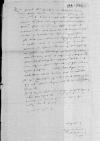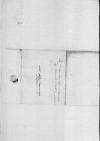List #2759
Sigmund von HERBERSTEIN do Ioannes DANTISCUSVienna, 1544-10-01
| odebrano Wormditt (Orneta), 1544-10-21 Rękopiśmienne podstawy źródłowe:
Pomocnicze podstawy źródłowe:
Publikacje:
| ||||||||||||||
Tekst + aparat krytyczny + komentarz Zwykły tekst Tekst + komentarz Tekst + aparat krytyczny
Reverendissimo domino, domino
Reverendissime Praesul, Domine observandissime et colendissime. Servitiorum meorum perpetuam commendationem.
Non potui me continere, quin ad Vestram Reverendissimam Dominationem de his, quae apud nos feruntur, paucis perscriberem. {Caesaream maiestatem} scribit
Ex
Vestrae Reverendissimae Dominationis obsequentissimus
[1 ] A reference to the imperial forces crossing the Marne (cf. cf. Elementa ad fontium editiones 37. Documenta ex Archivo Regiomontano ad Poloniam spectantia VII pars H B A, B 2, 1543-47, ed. by Karolina Lanckorońska, Roma, 1976 ⌊Elementa, XXXVII, No. 870, p. 108-109cf. Elementa ad fontium editiones 37. Documenta ex Archivo Regiomontano ad Poloniam spectantia VII pars H B A, B 2, 1543-47, ed. by Karolina Lanckorońska, Roma, 1976 ⌋)
[2 ] Andrzej Górka sent similar, though more detailed, news, which seems to have been largely propaganda, to Duke Albrecht von Hohenzollern in late October 1544. Because of the similarity of some expressions, one can guess that the information came from the same sources that Herberstein used in the present letter to Dantiscus (see cf. Elementa ad fontium editiones 37. Documenta ex Archivo Regiomontano ad Poloniam spectantia VII pars H B A, B 2, 1543-47, ed. by Karolina Lanckorońska, Roma, 1976 ⌊Elementa, XXXVII, No. 870, p. 108-111cf. Elementa ad fontium editiones 37. Documenta ex Archivo Regiomontano ad Poloniam spectantia VII pars H B A, B 2, 1543-47, ed. by Karolina Lanckorońska, Roma, 1976 ⌋; cf. cf. Martin du Bellay, Guillaume du Bellay, Mémoires de Martin et Guillaume du Bellay, vol. IV , ed. by V.-L. Bourrilly, Fleury Vindry, Paris, 1919 ⌊du Bellay, IV, p. 265-267cf. Martin du Bellay, Guillaume du Bellay, Mémoires de Martin et Guillaume du Bellay, vol. IV , ed. by V.-L. Bourrilly, Fleury Vindry, Paris, 1919 ⌋; letter cf.
[3 ] Antoine Perrenot de Granvelle as a bishop seldom resided in his diocese. He remained at the court and took part in various political campaigns, for example in the religious dispute at the diet in Worms in 1541, and in Regensburg in 1542. After the death of Charles V he was a diplomat in Philip II’s service, among other posts (cf. cf. Alfred Kohler, Karl V. 1500-1558. Eine Biographie, München, 1999 ⌊Kohler I, p. 128cf. Alfred Kohler, Karl V. 1500-1558. Eine Biographie, München, 1999 ⌋)
[4 ] Henry VIII Tudor as an ally of Charles V in the war against Francis I, he laid siege to Boulogne-sur-Mer from late July to September 14, wanting to join it to Calais – an English dominion on the continent (1360-1558) (see cf. Herbert A. L. Fisher, The History of England from the Accession of Henry VII to the Death of Henry VIII (1485-1547), London, 1919 ⌊Fisher, p. 462-463cf. Herbert A. L. Fisher, The History of England from the Accession of Henry VII to the Death of Henry VIII (1485-1547), London, 1919 ⌋; cf. Jasper Ridley, Henry VIII, [New York], 1985 ⌊Ridley, p. 383-385cf. Jasper Ridley, Henry VIII, [New York], 1985 ⌋)
[5 ] Forced to carry on a war on two fronts, from the start of the imperial-English invasion Francis I tried to hold peace negotiations. Henry VIII, however, had no intention of starting any talks before capturing Boulogne-sur-Mer on September 14 (cf. footnote 9). Meanwhile, after taking Saint-Dizier (see letter No. 39 footnote 17), Charles V was considering ending the campaign because of problems with provisioning, and was inclined to sign a separatist peace with the king of France, which would allow him to solve the growing religious problems in the Reich and to prepare a campaign against Turkey, in which, it was said, the emperor was to take part in person. Though preliminary peace talks were held from about mid-August, Charles V undertook further military action to put pressure on Francis I (see letter No. 39 footnote 18). The emperor expected that after breaking off the alliance with the sultan, Francis I would stand at the Habsburgs’ side in the anti-Turkish campaign and help deal with the religious relations on the eve of the expected general council. At this time, Francis I was conducting his own negotiations on the terms of a peace treaty with Henry VIII (through cardinal Jean du Bellay), in exchange for which the king of England demanded Boulogne-sur-Mer, among other things. On September 7, 1544 Charles V sent Antoine Perrenot de Granvelle to Henry VIII as he laid siege to Boulogne-sur-Mer (to Hardelot Castle), to obtain the king of England’s declaration whether he intended to continue the joint campaign against Francis I and march on Paris, or whether he agreed to the emperor signing a separate peace treaty with the king of France. On September 10, Henry VIII said he would not take part in the march on Paris. Perrenot returned to Crépy from his mission on September 18, the day the peace treaty was signed, though its terms had in fact been agreed a few days earlier. Perrenot later claimed that Henry VIII had agreed to the separatist peace treaty, but the king of England denied this (see cf. Vincent de Cadenas y Vincent, Diario del Emperador Carlos V (Itinerarios, permanencias, despacho, sucesos y efemérides relevantes de su vida), Madrid, Hidalguia, 1992 ⌊Cadenas y Vicent, p. 313-314cf. Vincent de Cadenas y Vincent, Diario del Emperador Carlos V (Itinerarios, permanencias, despacho, sucesos y efemérides relevantes de su vida), Madrid, Hidalguia, 1992 ⌋; cf. Manuel Fernández Álvarez, Charles V Elected Emperor and Hereditary Ruler, London, 1975 ⌊Fernández Álvarez 1975, p. 129cf. Manuel Fernández Álvarez, Charles V Elected Emperor and Hereditary Ruler, London, 1975 ⌋; Fcf. Manuel Fernández Álvarez, Carlos V, el César y el Hombre, Madrid, 2002 ⌊ernández Álvarez 2002, p. 656-657cf. Manuel Fernández Álvarez, Carlos V, el César y el Hombre, Madrid, 2002 ⌋; cf. Herbert A. L. Fisher, The History of England from the Accession of Henry VII to the Death of Henry VIII (1485-1547), London, 1919 ⌊Fisher, p. 462-463cf. Herbert A. L. Fisher, The History of England from the Accession of Henry VII to the Death of Henry VIII (1485-1547), London, 1919 ⌋; Jansen, VI, p. 258-259; cf. Robert Jean Knecht, Renaissance Warrior and Patron: The Reign of Francis I, Cambridge, 1994 ⌊Knecht, p. 493-494cf. Robert Jean Knecht, Renaissance Warrior and Patron: The Reign of Francis I, Cambridge, 1994 ⌋; cf. Alfred Kohler, Karl V. 1500-1558. Eine Biographie, München, 1999 ⌊Kohler I, p. 289-294cf. Alfred Kohler, Karl V. 1500-1558. Eine Biographie, München, 1999 ⌋; cf. Jasper Ridley, Henry VIII, [New York], 1985 ⌊Ridley, p. 384-385cf. Jasper Ridley, Henry VIII, [New York], 1985 ⌋; cf. Jack J. Scarisbrick, Henry VIII, Barkley and Los Angeles, 1968 ⌊Scarisbrick, p. 447-449cf. Jack J. Scarisbrick, Henry VIII, Barkley and Los Angeles, 1968 ⌋, cf. cf. Martin du Bellay, Guillaume du Bellay, Mémoires de Martin et Guillaume du Bellay, vol. IV , ed. by V.-L. Bourrilly, Fleury Vindry, Paris, 1919 ⌊du Bellay, IV, p. 259-281cf. Martin du Bellay, Guillaume du Bellay, Mémoires de Martin et Guillaume du Bellay, vol. IV , ed. by V.-L. Bourrilly, Fleury Vindry, Paris, 1919 ⌋; cf. Elementa ad fontium editiones 37. Documenta ex Archivo Regiomontano ad Poloniam spectantia VII pars H B A, B 2, 1543-47, ed. by Karolina Lanckorońska, Roma, 1976 ⌊Elementa, XXXVII, No. 870, p. 108-111, No. 871, p. 113cf. Elementa ad fontium editiones 37. Documenta ex Archivo Regiomontano ad Poloniam spectantia VII pars H B A, B 2, 1543-47, ed. by Karolina Lanckorońska, Roma, 1976 ⌋; cf. Corpus Documental de Carlos V, vol. 2 (1539-1548), ed. by Manuel Fernández Álvarez, Salamanca, 1975 ⌊CDCV, II, No. 284, p. 270, No. 313, p. 356cf. Corpus Documental de Carlos V, vol. 2 (1539-1548), ed. by Manuel Fernández Álvarez, Salamanca, 1975 ⌋).
[6 ] Nicolas Perrenot de Granvelle in 1521, at chancellor Mercurio Arborio di Gattinara’s side he took part in the Habsburg-French negotiations in Calais, and subsequently completed several missions to France up to 1528. In 1529 he took part in the peace negotiations with the Roman Curia and the Italian states, and in 1538 in Nice – in the talks on a truce with Francis I. In 1530, after Gattinara’s death, he succeeded him in the post of chancellor to Charles V. He was one of the emperor’s most trusted advisors and influential politicians. His correspondence with Dantiscus from the years 1529-1541 is known (cf. cf. Alfred Kohler, Karl V. 1500-1558. Eine Biographie, München, 1999 ⌊Kohler I, p. 127-128cf. Alfred Kohler, Karl V. 1500-1558. Eine Biographie, München, 1999 ⌋)

